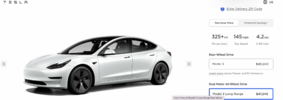Tesla just slipped the LR AWD Model 3 back into the US market with a reduced range battery which does not qualify for the full tax credit. And curiously, it's *exactly* the same price as the Model Y AWD, which does qualify.
This might hint at the reason the 3LR has been off the US market for 260 days. Perhaps they don't have enough Nevada 2170's to go around so they prioritized the high profit 3P and Y while shopping for a foreign alternative? Any guesses as to what this new mystery battery might be? It's too good for LFP and too expensive for 4680, so what does that leave?

This might hint at the reason the 3LR has been off the US market for 260 days. Perhaps they don't have enough Nevada 2170's to go around so they prioritized the high profit 3P and Y while shopping for a foreign alternative? Any guesses as to what this new mystery battery might be? It's too good for LFP and too expensive for 4680, so what does that leave?



